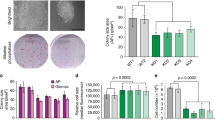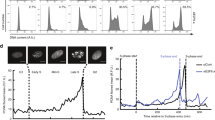Abstract
The E2F family of transcription factors play an important role in regulating cell cycle progression. We report here the characterization and functional properties of a new member of the human E2F family, referred to as E2F-7. E2F-7 has two separate DNA-binding domains, a feature that distinguishes E2F-7 from other mammalian E2F proteins, but resembling the organization of recently isolated E2F-like proteins from Arabidopsis. E2F-7 binds to DNA independently of a DP partner and delays cell cycle progression. Interestingly, E2F-7 modulates the transcription properties of other E2F proteins. A mutational analysis indicates that the integrity of both DNA-binding domains is required for cell cycle delay and transcriptional modulation. Biochemical results and protein modelling studies suggest that in binding to DNA interactions occur between the two DNA-binding domains, most probably as a homodimer, thereby mimicking the organization of an E2F/DP heterodimer. These structural and functional properties of E2F-7 imply a unique role in regulating cellular proliferation.
This is a preview of subscription content, access via your institution
Access options
Subscribe to this journal
Receive 50 print issues and online access
$259.00 per year
only $5.18 per issue
Buy this article
- Purchase on Springer Link
- Instant access to full article PDF
Prices may be subject to local taxes which are calculated during checkout








Similar content being viewed by others
References
Bandara LR, Buck VM, Zamanian M, Johnston LH and La Thangue NB . (1993). EMBO J., 12, 4317–4324.
Blattner C, Sparks A and Lane D . (1999). Mol. Cell. Biol., 19, 3704–3713.
Chan H-M, Smith L and La Thangue NB . (2001). Oncogene, 20, 6152–6163.
De Bruin A, Maiti B, Jakoi L, Timmers C and Leone G . (2003). J. Biol. Chem., 10, 42041–42049 (published online July 31).
de la Luna S, Burden MJ, Lee C-W and La Thangue NB . (1996). J. Cell Sci., 109, 2443–2452.
Di Stefano L, Rugaard Jensen M and Helin K . (2003). EMBO J., 23, 6289–6298.
Durocher D and Jackson SP . (2001). Curr. Opin. Cell Biol., 13, 225–231.
Dyson N . (1998). Genes Dev., 12, 2245–2262.
Field SJ, Tsai F-Y, Kuo F, Zubiaga AM, Kaelin Jr WG, Livingston DM, Orkin SH and Greenberg ME . (1996). Cell, 85, 549–561.
Gaubatz S, Lindeman GJ, Ishida S, Jakoi L, Nevins JR, Livingston DM and Rempel RE . (2000). Mol. Cell, 6, 729–735.
Hanahan D and Weinberg R . (2000). Cell, 100, 57–70.
Humbert PO, Rogers C, Ganiatsas S, Landsberg RL, Trimarchi JM, Dandapani S, Brugnara C, Erdman S, Schrenzel M, Bronson RT and Lees JA . (2000). Mol. Cell, 6, 281–291.
Klemm JD and Pabo CO . (1996). Genes Dev., 10, 27–36.
Komori H, Matsunaga F, Higuchi Y, Ishiai M, Wada C and Miki K . (1999). EMBO J., 18, 4597–4607.
Kosugi S and Ohashi Y . (2002). J. Biol. Chem., 277, 16553–16558.
Krek W, Ewen ME, Shirodkar S, Arany Z, Kaelin WG and Livingston DM . (1994). Cell, 78, 161–172.
La Thangue NB and Rigby PWJ . (1987). Cell, 49, 507–513.
Lee J-K, Huberman JA and Hurwitz J . (1997). Proc. Natl. Acad. Sci. USA, 94, 8427–8432.
Lin WC, Lin FT and Nevins JR . (2001). Genes Dev., 15, 1833–1844.
Lindeman GJ, Dagnino I, Gaubatz S, Xu Y, Bronson RT, Warren HB and Livingston DM . (1998). Genes Dev., 12, 1092–1098.
Moroni MC, Hickman ES, Denchi EL, Capara G, Colli E, Cecconi F, Müller H and Helin K . (2001). Nat. Cell Biol., 3, 552–558.
Morris L, Allen KE and La Thangue NB . (2000). Nat. Cell Biol., 12, 232–239.
Ogawa H, Ishiguro K, Gaubatz S, Livingston DM and Nakatani Y . (2002). Science, 296, 1132–1136.
Qin XQ, Livingston DM, Kaelin Jr WG and Adams PD . (1994). Proc. Natl. Acad. Sci. USA, 91, 10918–10922.
Rempel RE, Saenz-Robles MT, Storms R, Morham S, Ishida A, Engel A, Jakoi L, Melhem MF, Pipas JM, Smith C and Nevins JR . (2000). Mol. Cell, 6, 293–306.
Schwede T, Kopp J, Guex N and Peitsch MC . (2003). Nucleic Acids Res., 31, 3381–3385.
Shan B and Lee WH . (1994). Mol. Cell. Biol., 12, 8166–8173.
Stevens C and La Thangue NB . (2003). Arch. Biochem. Biophys., 412, 157–169.
Stevens C, Smith L and La Thangue NB . (2003). Nat. Cell Biol., 5, 401–409.
Trimarchi JM and Lees JA . (2002). Nat. Rev.: Mol. Cell. Biol., 3, 11–20.
Wu L, Timmers C, Maiti B, Saavedra HI, Sang L, Chong GT, Nuckolls F, Giangrande P, Wright FA, Field SJ, Greenberg ME, Orkin S, Nevins JR, Robinson ML and Leone G . (2001). Nature, 414, 457–462.
Yamasaki L, Jacks T, Bronson R, Goillot E, Harlow E and Dyson N . (1996). Cell, 85, 537–547.
Zheng N, Fraenkel E, Pabo CO and Pavletich NP . (1999). Genes Dev., 13, 666–674.
Acknowledgements
We thank M Caldwell for help in preparing the paper, and Adam Inche for assistance with the figures. This work was supported by Cancer Research UK, the Medical Research Council and the EU.
Author information
Authors and Affiliations
Corresponding author
Rights and permissions
About this article
Cite this article
Logan, N., Delavaine, L., Graham, A. et al. E2F-7: a distinctive E2F family member with an unusual organization of DNA-binding domains. Oncogene 23, 5138–5150 (2004). https://doi.org/10.1038/sj.onc.1207649
Received:
Revised:
Published:
Issue Date:
DOI: https://doi.org/10.1038/sj.onc.1207649
Keywords
This article is cited by
-
Adding pieces to the puzzle of differentiated-to-anaplastic thyroid cancer evolution: the oncogene E2F7
Cell Death & Disease (2023)
-
E2F1 and E2F7 differentially regulate KPNA2 to promote the development of gallbladder cancer
Oncogene (2019)
-
Functional interplay between E2F7 and ribosomal rRNA gene transcription regulates protein synthesis
Cell Death & Disease (2018)
-
E2F signature is predictive for the pancreatic adenocarcinoma clinical outcome and sensitivity to E2F inhibitors, but not for the response to cytotoxic-based treatments
Scientific Reports (2018)
-
Synergistic functions of E2F7 and E2F8 are critical to suppress stress-induced skin cancer
Oncogene (2017)



